4 min read
Barrick and Komatsu reach agreement on $440M equipment contract
- Press release,Company,Surface mining
November 22, 2020
Surface mining, Career development, Innovation and technology
10 min read

This year, we celebrate 100 years of the P&H shovel, recognizing the innovation driven by our employees to provide the highest level of quality and service support. That innovation was first started by P&H founders Alonzo Pawling and Henry Harnischfeger, who began a partnership in 1884 under the name Pawling & Harnischfeger, known as P&H. The company would go on to become Harnischfeger, and then Joy Global, before ultimately being acquired by Komatsu in 2017.
The foundation of their business became the backbone of where the shovel has progressed to, today. As Pawling & Harnischfeger expanded their business before the turn of the century, they began making DC and AC motors in 1893, required for the cranes they were building. P&H AC and DC motors continue to be the prime motors on virtually all P&H manufactured today.
While the foundation of machining and manufacturing started a century ago, developments throughout the years enhanced a machine to better meet the needs of the industries it served. The cornerstones of that being to increase productivity, maintainability, availability, and reliability, all while decreasing overall total cost of ownership.
From early on, P&H created a design for exceptional cutting force. The rigid rack-and-pinion-driven dual leg handle with high bail pull keeps cutting force at the teeth through the dig cycle.

The P&H electric rope shovels and hybrid shovel of today still use the rigid dual leg handle for cutting force.
The Roaring ‘20s brought rapid developments of roads, pipelines, airports and other infrastructure across North America. To provide customers with a machine that could move more, in 1920 P&H pioneered the gasoline-powered shovel, the P&H 206.
Gasoline shovels were a one-man-operated heavy-duty machine and could perform at an extremely low cost per yard. The feature most responsible for its success was the positive chain-driven crowding motion, operated from a set of planetary gears. The crowding motion made it possible for the shovel to dig in the most stubborn soils and to shake earth and clinging material loose from the dipper.

The P&H 206 was introduced in 1920 and was the first in a long line of high-performance digging machines.
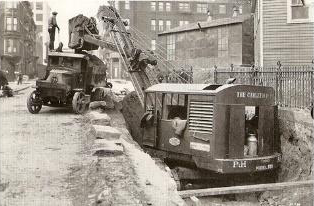
A P&H 600 digging the New Brooklyn Subway in New York in 1928. It offers a larger capacity and swing control, giving the operator enough control to work in tight corridors — beneficial for infrastructure work in cities.
To meet additional demands of rapid development, contractors were looking for equipment that offered versatility, that could be used across multiple projects. P&H created a machine that could serve more than one purpose, the P&H Model 300 8-in-1 Convertible.

The Model 300 was a sturdy crawler-mounted platform upon which the customer could specify attachments, including a front shovel, backhoe, “skim-scoop,” dragline, construction hook crane, construction clamshell crane, scrap yard magnet attachment or pile-driver configuration.
To provide increased machine strength and payload capacity, P&H began to replace the riveted-construction machinery with an all-weld design in 1930. P&H was the first manufacturer to do so and became so well-versed in welding technology, began to develop and manufacture its own line of welding machines and consumables.
Post-war reconstruction and global economic growth drove the need for bigger, more efficient digging machines in the 1950s.
It was a time to transition from a construction machine. As truck sizes increased, customers were looking for bigger machines that could keep up to match their capacity and production needs. Several excavator models during this time featured a new friction-free Magnetorque electromagnetic clutch drive on the hoist. It made possible smooth, rapid dipper passage through the bank without stalling and with increased dipper fill performance.
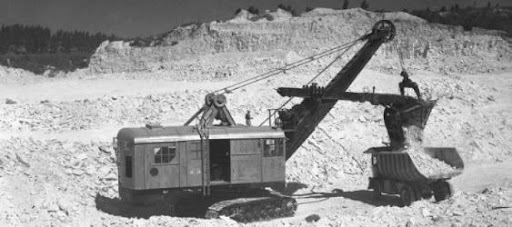
P&H 1300WL shovels were equipped with Ward-Leonard DC drive controls to increase digging performance. The Ward-Leonard DC control system freed machine operators from the exertion of tired hands and arms to push and pull excavator mechanical levers, resulting in increased machine responsiveness, speed, power and productivity.

In 1969, P&H released the 2800MkI with several innovations in mechanical systems to help increase productivity. The move to a dual-motor hoist drive for increased power and productivity reduced rotational inertia to provide a more responsive hoist system.

In the propel system, the simplified, efficient straight-line drive of propel-in-the-lower eliminated all the vertical and horizontal propel power shafts from the upper deck to the lower drive. Fewer gears, shafts and bearings meant better shovel control, reduced maintenance, increased reliability and long-life service.
Along with the mechanical innovations came electrical innovations. The 2800MkI debuted with a solid state “electrotorque” control system that eliminated the double energy conversion, and Joystick control for the swing function that eased the machine operation.

In 1975, maintainability was enhanced with a pin lug dipper handle to simplify dipper changeouts. For improved maneuverability, a dual propel drive eliminated complicated clutch arrangement, introduced in 1981.

In 1984, the planetary propel simplified the propel drivetrain further, dramatically decreasing maintenance. A planetary swing was introduced several years later, leveraging the propel planetary to improve manufacturing throughput. The planetary swing also decreased maintenance time by simplifying the swing drivetrain.
The first 4100 Series Electric Shovel was introduced in 1991. With the arrival of 270-ton haul trucks, the customer need for larger shovels capable of three-pass loading prompted development of the P&H 4100 with a 45-cubic-meter nominal dipper capacity and a 90 short tonne payload rating. Ongoing refinements would transform the machine into a higher-performance, higher-capacity shovel. P&H engineers and manufacturing specialists applied planetary propel and swing transmissions, modular hoist drive, a sealed electrical room, modular crowd case and other state-of-art technology to make the new shovel highly productive and easy to maintain for a reduced operating cost.

The P&H 4100TS was launched in 1997 for oil and mining operations, having ultra-wide crawlers, designed to allow oil sands customers to meet the high production demands and low ground bearing pressure requirements.
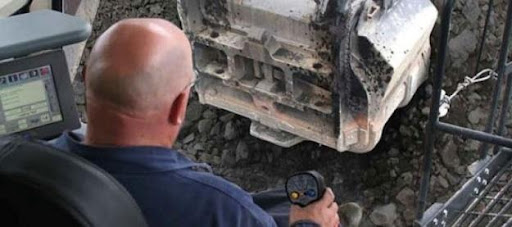
Introduced on the 4100XPC in 2004, the Centurion electrical control system meant more loading control, along with other advanced operator cab technology. Centurion provided a modern digital supervisory controls system, which became the foundation for machine troubleshooting and technology moving forward.

In 2009, P&H introduced its class-leading 4100XPC shovel with a fully AC drive system. The shovel features a factory-built modular rear room, P&H designed and manufactured AC motors in all locations, and enabled push button propel on demand. The enhancements increased the productivity of the machine by 6%.
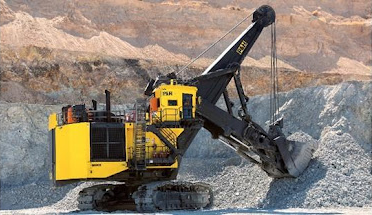
Combining the advantages of a rope shovel and a hydraulic face shovel, in 2016 the P&H 2650CX hybrid shovel was introduced. Powered by dual diesel engines and electric drives, it utilizes hydraulics on the crowd system to enhance digging selectivity and enable bucket curl while delivering traditional P&H dig performance and helping to achieve a reduction in total cost of ownership.

The dipper is one of the hardest working pieces of equipment on the electric shovel. Launched in 2018, the TRC series dippers help minimize field maintenance and maximize performance with its trapezoidal body, roller latch system and door, and a cast equalizer.

Several new technologies provide insights to get the most from the machines. Online Vibration Monitor 2 enables operators to realize the power of predictive diagnostics, helping limit lost production from unplanned shutdowns. Adaptive Controls 2 helps improve productivity by the intelligent application of power — a first step toward shovel autonomy.
Manufacturing the highest quality equipment is a challenging and complex undertaking that requires a diverse team of skilled employees. It takes the hard work and dedication of all our employees, throughout the entire organization, to make us successful.
In 1985, Henry Harnischfeger (grandson to the founder), then president of Harnischfeger, stated: “… some look at this company as products and plants, or as budgets and balance sheets. When I look at the company, I see people — particularly employees, in Milwaukee and all over the world, who have devoted their active professional careers to Harnischfeger. They have pursued a common goal of excellence and they have always been our most essential resource.
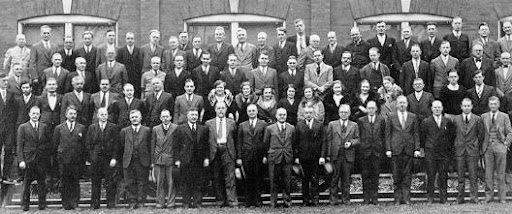
The P&H team of engineers outside the manufacturing facility in 1934. Today’s diverse team of engineers for Komatsu are located around the world in every facet of engineering.

A look at the engineering department in 1934. The drafting room of the 30s had large windows so the work of designers, details and tracers could be done in natural light. engineering drawings and records were kept in a large fireproof vault in the center of the drafting room.
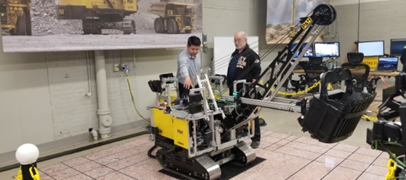
Engineers today work in facilities around the globe. The Automation Lab in Milwaukee, Wisconsin, provides a very low-risk environment to try out research and development concepts for shovels and drills and has 1:12 scale robots. A variety of engineers work in this group, including mechanical, electrical, software and even a nuclear engineer on the team.


A machinist working on a spline in the 1930s at the P&H machine shop.

In 2019, the manufacturing facility in Milwaukee, Wisconsin, received a new spliner, which can make shipper shafts large enough for our 4800 shovel. The company made gears before it made machines and today, as a gear mother plant for Komatsu, the facility is positioned as the core of global production for gears.

A look into the 1930s P&H machine shop. By 1930, P&H employed 1,500 workers.
The challenges of mining today are driving advanced technology and automation to help improve safety, sustainability and increased production while reducing costs. To ensure customers are equipped to meet those demands, we are actively moving toward the future with our line of P&H rope shovels.
“Pawling and Harnischfeger would be really excited about what the business has become today,” said John Koetz, president of surface mining for Komatsu. “Excited about the endurance of the brand, the breadth and the scope of the business as we've expanded, and with the continued legacy of support and reliability.
I think they'd also be really excited, as we are, in the South Harbor Campus development, that remarkable workplace for the next century for this business.”
The site of a new state-of-the-art facility will be the South Harbor Campus, located in the Harbor District, near the original site of Pawling and Harnischfeger’s original Machine and Pattern Shop.
The South Harbor Campus will be the new home for the design, large gearing and heavy fabrication of P&H mining shovels, as well as engineering and test manufacturing for surface drills. It will be a space to innovate and collaborate, host training and customer visits and proudly display our manufacturing and technological capabilities.

Contractors at the site of the South Harbor campus in Milwaukee are utilizing components of Komatsu’s own Smart Construction technologies. Introduced earlier this year, Smart Construction taps into the power of the Internet of Things (IoT) to enable contractors to control construction planning, management, scheduling, costs, and optimize processes remotely — in near real time.
We’ve got a tremendous opportunity in front of us with as part of Komatsu and the part of those 60,000 employees of Komatsu worldwide and their investment in this business,” said Koetz. “It's a tremendous opportunity for us not only create the physical campus for the next century but to create the innovations, the automation, the technology and the people who will lead us there in the future.”
Explore the career possibilities at Komatsu.
